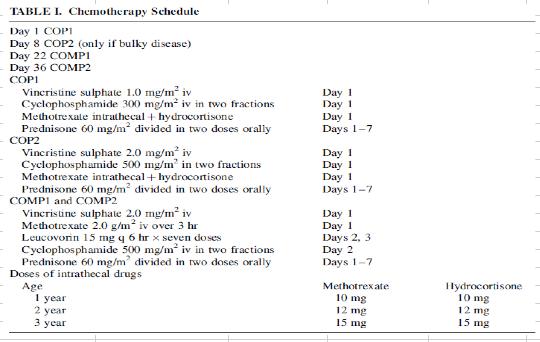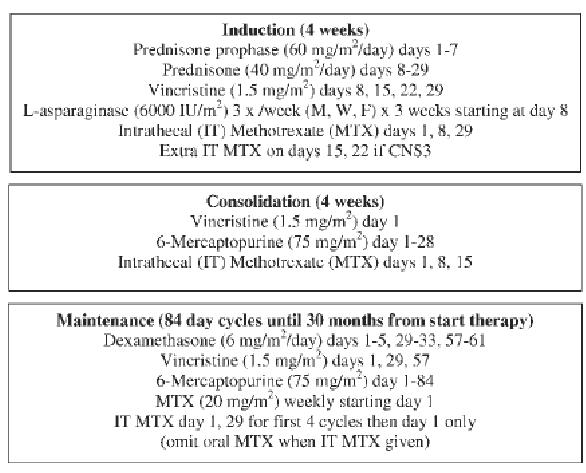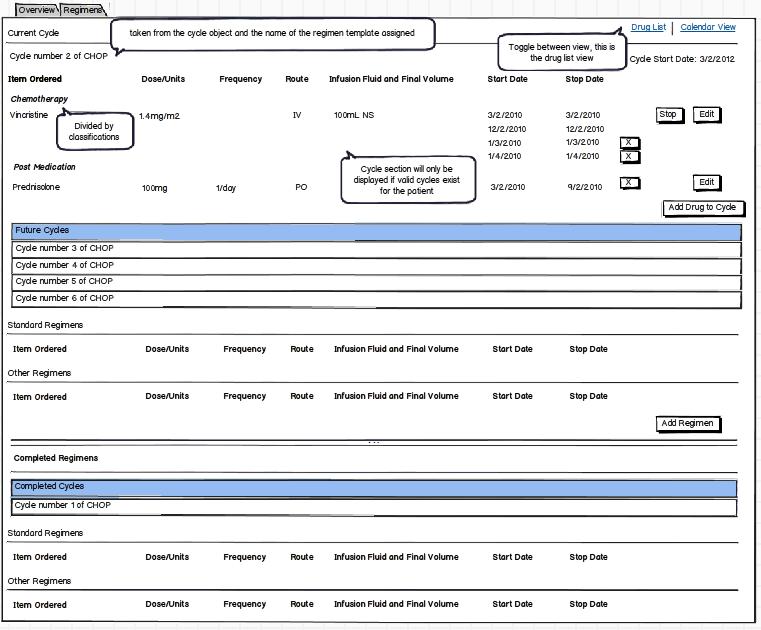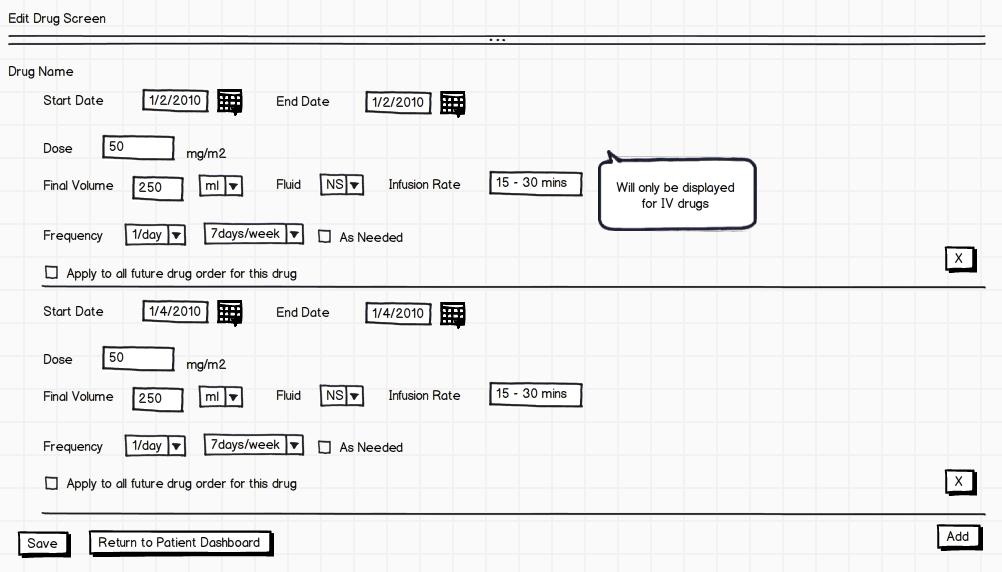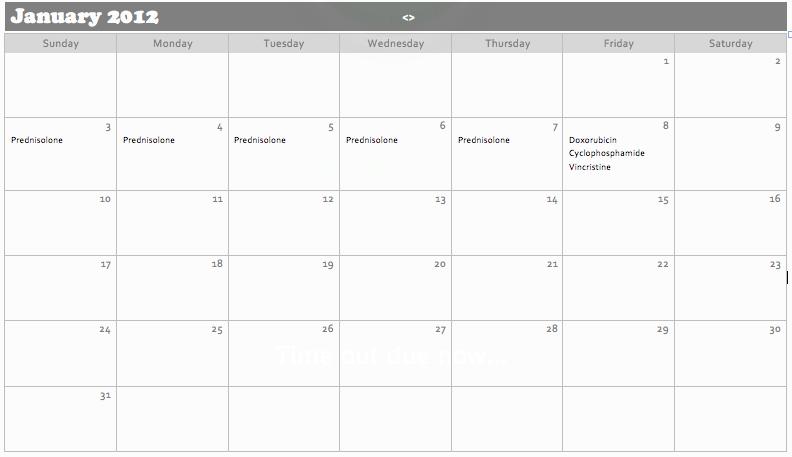Chemotherapy Regimen Requirements
Drug Orders
The following information needs to be recorded for each drug order
Name | Existing Y/N | Database Field | Values | Comments |
Drug | Y | Drug.Name |
|
|
Dose | Y | Drug_Order.Dose |
| Need to add additional units in the form of mg/m2 and mg/kg (as the actual dose given at a visit is based on the patients weight) |
Route | Y | Drug.Route | IV, PO |
|
Infusion volume |
|
| Numeric | Values such as 250ml |
Infusion volume units |
|
| Standard liquid units |
|
Infusion liquid |
|
|
| Values need to be configurable via global properties |
Time/Infusion Rate |
|
| Free text because values include ranges (ie 15-30) minutes |
|
Frequency | Y | Drug.Frequency |
| Current values plus the addition of as needed |
Cycle |
|
|
| Chemotherapy treatment is administered in cycles, so knowing which cycle a given drug order is for will be useful. |
Classification |
|
| Premedication, Chemotherapy, Postmedication | The classification is necessary for display purposes so that we can prepare sensible patient summaries |
Start Date | Y | Order.start_date |
| For many of the actual chemotherapy drugs the start and stop dates will be on the same day. |
Stop Date | Y | Order.auto_expire_date |
|
|
Notes: for the majority of the chemotherapy drugs the dose administered is determined based on the patient’s weight at the time of treatment. Therefore when the drug order is created the dosage will read something similar to 50mg/m2, the actual dose the patient receives will be based on body surface area (calculated based on height and weight at visit).
This is an example of a common chemotherapy (CHOP) cycle administered in Rwanda
1.PREMEDICATION
Date and time | Drug and dose/ m² or/ kg | Actual dose | Route | Infusion fluid and final volume | Time /infusion Rate |
| NS 500mL |
|
|
|
|
| Ondansetron | 8mg | PO |
|
|
| Promethazine | 25mg | IV |
|
|
| Cimetidine | 300mg | IV |
|
|
| Prednisolone | 100mg | PO | For five days |
|
2. CHEMOTHERAPY
Date and time | Drug and dose/ m² or/ kg | Actual dose | Route | Infusion fluid and final volume | Time /infusion Rate |
| Doxorubicin 50mg/m2 |
| IV | 250 mL NS | 15-30 minutes |
| Cyclophosphamide 750mg/m2 |
| IV | 500mL NS | One hour |
| Vincristine 1.4mg/m2 |
| IV | 100mL NS | 15 minutes |
|
|
|
|
|
|
3. POST CHEMO
Date and time | Drug and dose/ m² or/ kg | Actual dose | Route | Infusion volume | Time /infusion Rate |
| NS 500mL |
|
|
|
|
Examples of more complicated treatment plans.
These indicate the treatment plans as they would be entered up front for a patient. Throughout the course of treatment the drugs and dosages may be customized for the patient due to side effects.
Regimen Templates
Due to the complicated nature of oncology regimens, rather than forcing the user to add all drugs individually to the patient record we will allow for the creation of regimen templates. It is common for the standard oncology regimens to be customized to meet individual patients needs, therefore we will need to allow for the individual components of the regimen to be changed once a regimen template has been applied to the patient.
Screen design for the creation of a regimen template
Notes:
- Each regimen template will be assigned a display name.
- The user can also opt to denote the template as being cyclical in nature (for example the CHOP is generally administered for 6 cycles). If the cycle option is ticked the user will need to specify the length of the cycle in days.
- Functionality will exist to edit exiting regimen templates.
- A Regimen template will consist of one or more drugs.
For each drug the following information will be saved into the template
Drug – A drop down box listing all the concept drugs held within the system.
Classification – An optional field that allows the drug to be classified for display purposes. The classification will be a drop down box of system-defined classifications.
Dose – the initial dose that should be applied to the drug. The units for the dose will be populated from the information held against the concept drug once the drug is selected.
Infusion Information – if the concept drug has been assigned a route of IV then additional infusion fields will be displayed
Infusion Volume – the final volume of liquid that will be administered to the patient. This will be a numeric field.
Infustion Units – the unit the Infusion Volume field has been entered in. This will be a combo box of valid unit fields and should default to ml.
Infusion Liquid – this is the liquid in which the drug will be administered. This will be displayed as a list of pre-defined infusion liquids. The liquids will all be held as concept values and the combo box should display the short name recorded against the infusion concept.
Start Day – this is used to denote when the drug should be administered in relation to the cycle start date. For drugs that are to be taken continuously throughout the cycle the start date should be set to 1 and the stop date should be left blank (this will denote a continuing drug order). For drugs that are to be administered for a fixed period of time(for example the prednisolone in the CHOP protocol), these drugs should be given an appropriate start and stop day that denotes the period for which the drug should be taken. For drugs that are to be administered only on particular days, the start and stop day should be the same. For drugs that are administered more than once throughout a cycle, additional start and stop days can be added for a given drug to denote that a drug needs to be taken on day 1, 29, 57 for example.
Frequency – this frequency in which the drug should be taken on the days that it is to be administered. These will be optional fields that should be filled out when it makes sense for the drug. There will also be an optional check box to indicate that the drug should be taken as needed rather than on a regular schedule.
Cycles
Oncology regimens tend to be cyclical in nature. For example the CHOP protocol is generally administered in six cycles to a patient. In order to group drug order into a distinct cycle and to also to allow for helper methods to manipulate all drug orders within a cycle, a drug order cycle object will be created. The cycle reference on a drug order will be an optional relationship.
The following information will be held within the drug order cycle object.
Field | Description |
Start Date | The date the cycle started on |
End Date | The date the cycle is considered finished on |
Regimen Template | So we have a way of linking all the cycles of the same treatment plan together |
Cycle number | The number of the cycle (for example cycle 2 out of 6) |
Patient Dashboard Regimen Tab
Currently the patient dashboard regimen tab catergorises drug orders into current and completed (divided into standard regimens and other regimens). For the new Regimen tab we also want to categorise drug orders based on the cycles and classifications.
The following screenshot shows the layout of the new Regimen tab.
Notes:
- If any cycles are present these will be displayed for the patient, if no cycles are present then this entire section will not be displayed.
- Upon loading the current cycle will be displayed, all future cycles can be expanded as needed.
- All drugs orders in the cycle will be displayed as part of the cycle even if completed.
- For all drug orders (within a cycle or not) if the drug order has commenced then the user will have the option to delete or stop the drug order. Users will not be able to edit dosages etc, in this scenario they would need to stop the drug order and create a new one (so that we have an accurate history of drug orders. If the dosage has been entered incorrectly then the user can delete the drug order and recreate it with the correct information.
- For all drug orders that have not yet started the user will have the option to delete the order or to edit the order (in order to change dosages etc).
- All the separate drug orders of the same type of drug within a cycle will be grouped together.
- Within future cycles the user will have the option to change the cycle start date (which will affect the start date of all drug orders within that cycle). As well as allowing for entire cycles to be deleted.
- The Add Drug to cycle will open a screen similar to the Edit Drug Screen with the exception that the drug name will be a drop down list of all drugs in the system.
When the user selects the Edit button against a drug the following screen will be displayed.
Notes:
- This will display all instances of the drug orders for that drug within the given cycle.
- Changes to dosages and frequency can be applied to all future drug orders of that drug (whether in that cycle or future cycles).
When the Add Regimen button is selected from the Regimen tab the following screen will be displayed
Notes:
- Only one of the dropdown boxes can be used at a time
- When adding multiple cycles there will no gap between the cycles (eg, cycle if cycle one stops on the 1/2/2012, cycle 2 will be set to start on the 2/2/2012).
The patient dashboard will also offer a calendar view. The calendar view will display all completed, current and future drug orders in the system in calendar format. Different colors will be used to denote current and continuing drug orders, completed drug orders and future drug orders.
Concept Drug Screen
The Concept Drug Management screen will need to be altered to allow for the Route field to be configurable for Concept Drugs.
Settings (formerly Global Properties from platform 1.8 downwards) Additions
Settings (formerly global properties from platform 1.8 downwards) (or other configuration mechanisms) will need to be added to store the following.
Routes – to store the valid Route values that can be assigned to a drug via the concept drug screen.
Classification – to store the valid Drug classifications that can be assigned to a drug either by a regimen template or through the patient dashboard. Each classification will need to have an order so that we can display it in the correct order on the patient dashboard and summaries.
Infusion Volumes – to store the valid infusion liquids that can be used in conjunction with IV route drugs. The infusion liquids will be created as concepts within the concept dictionary.
